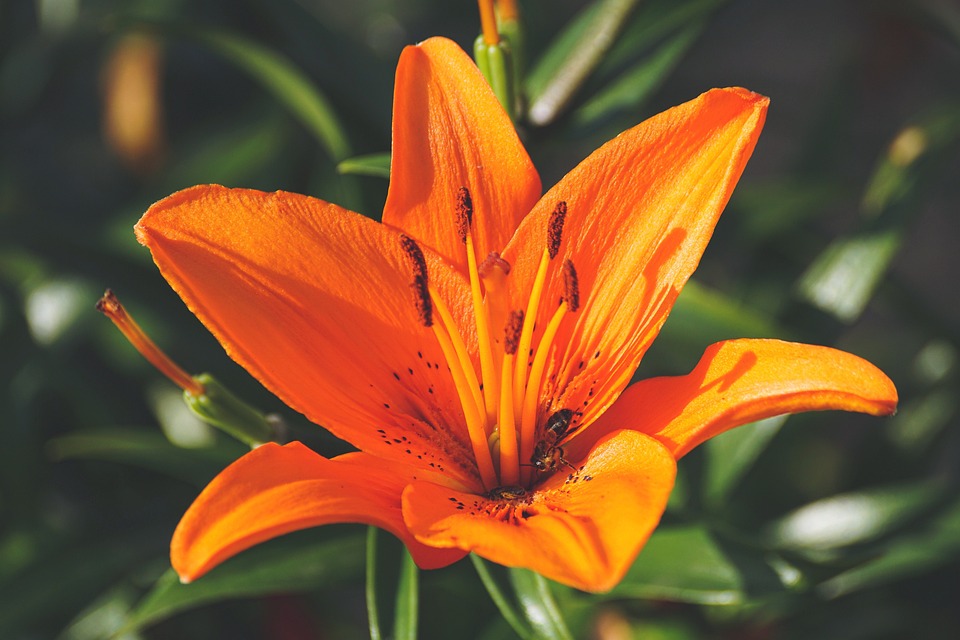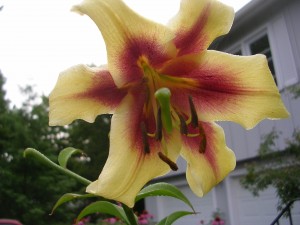Learn how to grow lilies including Asiatic and Oriental varieties.
Listen to podcast:
Other Name
many different types
Sun Requirements
full to part sun
Bloom Period and Seasonal Color
Summer in colors including white, yellow, pink, red, orange and bi-colors
Mature Height x Spread
1 to 6 feet x 1 to 2 feet
Added Benefits
attracts beneficial, attracts hummingbirds, drought tolerant
True lilies shouldn’t be confused with similar-looking daylily. True lilies are bulbs that dieback in fall but return each year. Daylilies aren’t even in the lily family and are herbaceous perennials. I cover those in the perennials chapter. The range of lily varieties and colors is staggering. From the tall trumpet lilies to the fragrant oriental lilies to the classic Easter lily, these spectacular flowers put on a show in the summer garden and are great for cutting as well. I often pick a bouquet of fragrant oriental lilies to perfume the house in summer. Lilies produce tall flower stalks with multiple flower buds per stalk. By selecting different varieties you can have blooms in your garden most of the summer.
Where, When and How to Plant
Most lilies are hardy throughout our region, but may have difficulty returning each year if grown on heavy, wet clay soil. Buy bulbs from the local garden center in spring or fall and plant in full sun on well-drained soil. Plant bulbs 3 times their diameter deep and spaced at least 1 foot apart. Sprinkle a small handful of bulb fertilizer in the hole.
Growing Tips
Fertilize in spring with an all purpose bulb food. Keep the area free of weeds and mulched with bark mulch to preserve soil moisture. Lilies will tolerate dry period once established. Stake tall varieties of lilies to keep them from flopping over. Cut back spent flower stalks after blooming, but let the leaves naturally yellow and die to rejuvenate the bulb.
Regional Advice and Care
Mice, voles and chipmunks will feed on the bulbs. Sprinkle a handful of crushed oyster shells or crushed seashells in the planting hole or grow the bulbs in a cage. The red lily leaf beetle is a devastating insect on Asiatic and Oriental lilies, in particular. Handpick the bright red adults in spring as the lilies emerge. Spray Spinosad to control the black, slug-like larvae that hatch on the leaf undersides.
Companion Planting and Design
Plant lilies in a perennial flower border near lower growing annuals and perennials such as lady’s mantle, geranium and mounding zinnias. These low growers will hide the unsightly bottom of the lily plants. You can also grow lilies in a cutting garden.
Try These
Asiatic lilies bloom in early summer on 3 to 4 foot tall flower stalks and feature colorful flowers, but no fragrance. ‘Gran Paradiso’ (red), ‘Chianti’ (pink) and ‘Gironde’ (yellow) are some popular varieties. Oriental lilies bloom in mid summer on 2 to 5 foot tall flower stalks and are fragrant. Some varieties include ‘Stargazer’ (white with pink) and ‘Pink Pearl’ (pink). Trumpet lilies grow up to 6 feet tall with trumpet-shaped, colorful flowers. Easter lilies are in this group, but they are marginally hardy in colder parts of our region. Orienpet lilies are a cross between oriental and trumpet lilies. They are tall growing, and colorful, but still have a fragrance. ‘Caravan’ is a popular yellow and red variety.
Excerpted from my book, New England Getting Started Garden Guide.
Podcast Transcript
It’s the symbol of nobility, fertility, virtue and purity. Some believe these flowers will even ward off ghosts and evil spirits. What common perennial is it? It’s the lily.
 While we all know Easter lilies, there are other types that are easier to grow. The first to bloom is the Asiatic lilies with their bright red, pink, yellow and orange colored flowers. They grow 30 inches tall and new varieties, called the ‘LA Hybrids’, have an Easter lily like fragrance. For tough lilies try the Turk’s cap and Tiger lilies. These are hardy to zone 3 and grow 4 feet tall with clusters of colorful flowers. Finally, the last to bloom are the Oriental lilies. These pastel colored beauties grow only a few feet tall, but will knock your socks off with their fragrance. The Orienpets are a cross between the Oriental and Trumpet lilies producing a fragrant flower with bold colors.
While we all know Easter lilies, there are other types that are easier to grow. The first to bloom is the Asiatic lilies with their bright red, pink, yellow and orange colored flowers. They grow 30 inches tall and new varieties, called the ‘LA Hybrids’, have an Easter lily like fragrance. For tough lilies try the Turk’s cap and Tiger lilies. These are hardy to zone 3 and grow 4 feet tall with clusters of colorful flowers. Finally, the last to bloom are the Oriental lilies. These pastel colored beauties grow only a few feet tall, but will knock your socks off with their fragrance. The Orienpets are a cross between the Oriental and Trumpet lilies producing a fragrant flower with bold colors.
Plant lily bulbs now or in the fall in well-drained, fertile soil. Amend poorly drained soils heavily with compost. Tall growing Trumpet and Tiger lilies may need staking in windy areas. The main pest of bulbing lilies is the red lily leaf beetle. This red beetle emerges in spring to feed on the leaves. It then lays eggs on the leaf undersides that hatch into black, slug-like larvae that love to eat. They particular like the Asiatic lily varieties. Luckily, there are some controls. Try growing more resistant varieties such as ‘Madame Butterfly’ and ‘Black Beauty’. In spring, hand pick adults, spread diatomaceous earth around emerging bulb shoots to repel them and check under the leaves for the red egg masses and crush them. Hand squish any black larvae that survive as well and spray Spinosad organic insecticidal on the plants in the evening when honeybees are less active.



